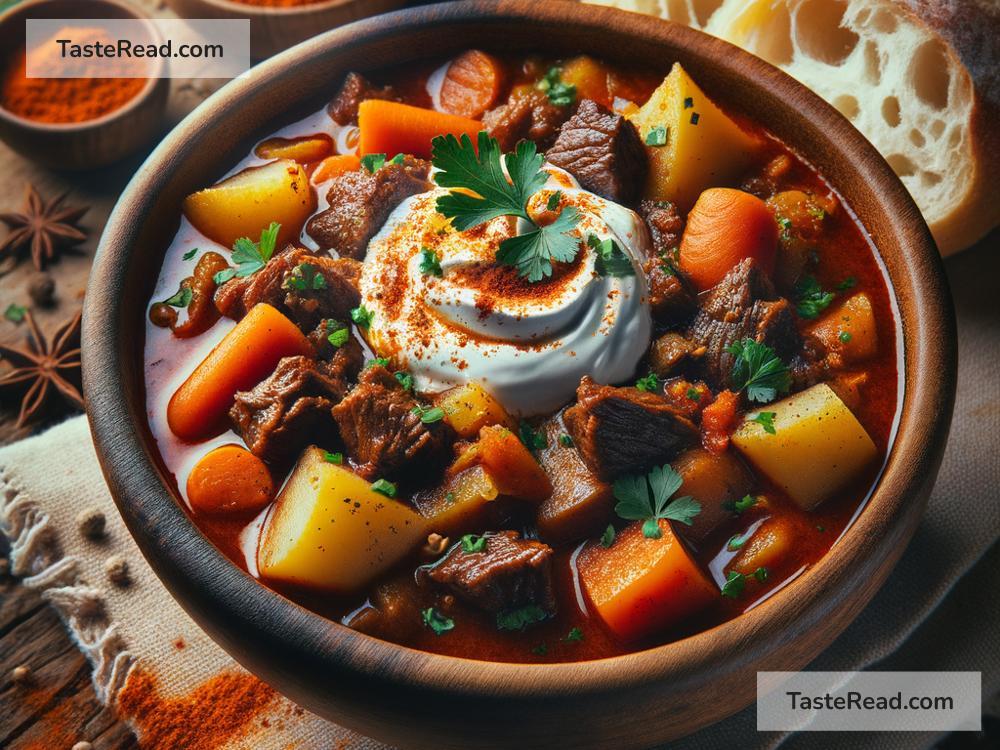Hungarian Goulash: A Delicious Symbol of National Identity
Hungary is a country with a rich history, vibrant culture, and an exceptional cuisine. Among its many culinary treasures, goulash stands out as the most famous dish. This hearty stew, made with beef, vegetables, and paprika, is not just food; it’s a symbol of Hungarian pride and national identity. Let’s explore how goulash became such an important part of Hungarian culture and why it remains a beloved dish to this day.
What Is Hungarian Goulash?
Hungarian goulash (in Hungarian, “gulyás”) is a traditional dish that has been cherished for centuries. It is made with simple ingredients like meat (usually beef or pork), onions, carrots, potatoes, and spices, with a special focus on paprika. Paprika, a spice made from dried peppers, gives goulash its distinctive red color and rich flavor. Paprika is so important to Hungarian cooking that it’s almost impossible to think of Hungarian food without it.
There are different versions of goulash, and every family has its own recipe. Some like it thick, almost like a stew, while others prepare it as a soup. No matter how it’s made, goulash is always warm, comforting, and full of flavor. It’s more than just a meal; it’s a piece of Hungarian heritage served on a plate.
The Origins of Goulash
The history of goulash dates back hundreds of years. The word “gulyás” originally referred to Hungarian herdsmen, or cowboys, who looked after cattle in the grassy plains known as the Puszta. These cowboys made a simple, hearty dish that could feed them while working outdoors. They cooked meat and vegetables in a large pot over an open fire, creating what we now know as goulash.
Over time, this rustic meal evolved into a national dish. As Hungary grew and changed, so did its cuisine. New ingredients like paprika were introduced in the 16th century, and by the 18th century, paprika became a key part of Hungarian cooking. With its deep, smoky flavor, paprika became the soul of modern goulash, and the dish grew in popularity across all social classes.
Goulash and National Identity
Goulash is much more than just a tasty meal. It’s deeply connected to Hungary’s history and sense of identity. During the 19th century, Hungary was part of the Austro-Hungarian Empire, and many Hungarians felt their culture was being overshadowed by Austrian influences. At this time, Hungarian intellectuals and nationalists emphasized the importance of preserving their unique traditions. Goulash, as a truly Hungarian dish, became a symbol of unity and pride.
Even today, goulash represents the resilience and creativity of the Hungarian people. It shows how a simple dish, made from humble ingredients, can become a powerful cultural icon. No matter where in the world it’s served, goulash reminds people of Hungary’s rich history and its contributions to global cuisine.
Why Is Goulash So Special to Hungarians?
There are many reasons why Hungarians love goulash. First, it’s deeply rooted in their traditions and ways of life. Eating goulash connects people to their ancestors, who made this dish in the Puszta or in villages. Second, it’s a meal that brings people together. Goulash is often cooked in large quantities to share with family and friends, especially during special occasions or celebrations.
Making goulash is also an experience in itself. Hungarian families often cook it outdoors in a large pot, called a “bogrács,” over an open fire. This method, known as “bográcsgulyás,” makes the meal taste even better and creates a fun atmosphere for everyone involved. The smell of paprika and simmering meat fills the air, making it impossible to resist.
Goulash Around the World
Hungarian goulash has become famous far beyond Hungary’s borders. Today, it is cooked and enjoyed in many different countries, though recipes can vary. Some people add their own twist by including ingredients like sour cream, mushrooms, or wine. While these adaptations are delicious, traditional Hungarian goulash remains the gold standard.
For Hungarians living abroad, cooking goulash is a way to stay connected to their roots. It brings back memories of home and preserves traditions that might otherwise be forgotten. In this way, goulash continues to act as a bridge between Hungary and the rest of the world.
A Dish That Unites
Hungarian goulash is more than a dish; it’s a piece of history, a symbol of unity, and a source of comfort. From its humble beginnings in the plains of Hungary to its place on tables around the world, goulash tells the story of a nation and its people. It is a reminder that food is not just about nourishing the body but also the soul, connecting us to our past and bringing us closer to each other.
So, the next time you sit down to enjoy a bowl of Hungarian goulash, think about the history behind the dish. Whether you cook it at home or enjoy it in a restaurant, you are tasting a small but important part of Hungarian culture. And that’s something truly special.
Hungarian goulash is a proud symbol that proves even the simplest dishes can tell the biggest stories. It’s warm, flavorful, and full of history—a recipe for love and connection that’s passed down from one generation to the next.


